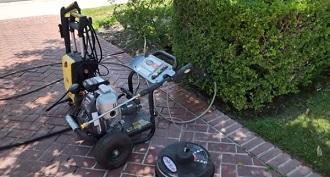As an Amazon Associate, this site earns commissions from qualifying purchases. For more information click here.
Your pressure washer has been working flawlessly when suddenly it only wants to run on choke. What could this mean? Does this require a trip to the repair center? By reading this guide you will learn the reason why this happens and how to fix it.
The most likely reason why a pressure washer only runs on choke is too much air in the carburetor. This is usually caused by an air leak or limited fuel in the engine. This problem can also be due to old fuel left in the tank.
Those are the most likely causes, but how can you fix them? That is what will be in explained in detail next. Before we do so, it is important to understand what choke is. Knowing what it does is essential to understanding and fixing the problem.
What is a Pressure Washer Choke?
The choke is a valve that restricts the amount of oxygen which goes into the carburetor. Running a pressure washer on choke helps the engine start in cold temperature. The choke valve is a standard feature in outdoor and garden tools running on small engines.
Engines need high temperatures to start. By limiting the amount of oxygen, more gas becomes available for the system. This enables your pressure washer to start up even in cold weather.
However, pressure washers should only run on choke for a few seconds. Once the engine starts the valve should turn off. A pressure washer only needs to use the choke to start in cold weather. If the pressure washer needs the choke to operate, there is a problem.
Now that you know what a choke does, here are the most common causes and fixes.
Note: wear gloves and eyewear protection. Perform these troubleshooting repairs outdoors. Take all necessary precautions when handling fuel. Do not attempt this indoors and keep the pressure washer away from flammable material.
Carburetor Air Leak
Excess air can leak through the fuel line, gasket, hose, air filter or physical damage to the housing. Any sort of leak can cause all kinds of problems.
How to fix it. Find the source of the leak and fix or replace the part. Follow these steps.
- Turn off the pressure washer.
- Wear gloves and eye protection.
- Inspect the engine and the carburetor. Check the fuel line first. If there is a leak here it is likely the reason your pressure washer only runs on choke. A damaged fuel line has to be replaced.
- If the fuel line is working, check the gasket, hoses and other parts of the engine. Eventually you will find the leak source. Replace that part and put the engine cover back on. Try the pressure washer.
You should also check if the carburetor needs cleaning or replacement. A clogged carburetor can produce all sorts of problems unless it is cleaned. If the carburetor is dirty or clogged, give it a thorough cleaning.
You will need a carburetor rebuild kit to fix or replace some parts. Make sure the kit you buy is compatible with your pressure washer. The Hipa GX160 carburetor rebuild kit is for Honda GX200 engines for example.
This video shows you how to clean a small engine carburetor. This method works for pressure washers as well as chainsaws, lawn mowers and other outdoor power tools.
Wrong Fuel
Pressure washers can only use regular unleaded 87 octane gas with 10% ethanol. The lower the ethanol level the better. Replace pressure washer fuel every 30 days.
How to fix it. You can use any fuel brand as long as it meets the requirements stated above. If you use the wrong fuel the engine might not run at all. Using the wrong fuel type also makes it impossible for a pressure washer to remove algae.
A lot of pressure washers run on 4-stroke engines so mixing gas and oil is not needed. If you have a 2-stroke pressure washer, mix the fuel according to the ratio provided by the manufacturer.
Check the fuel to air mix. If the fuel is correct but the pressure washer won’t run, check the air to fuel mix. If it is too lean (too much air) the engine won’t have enough fuel to run. Too much air and the engine will not function properly.
Old Fuel
All small engines require fresh fuel every 30 days. If you do not change the fuel it will clog the carburetor. Eventually the engine may cease running.
As gas gets old, it turns into a thick, gummy substance. The color turns darker and the smell turns sour. If you notice any of these signs, it means the gas has been left too long in the pressure washer.
What happens when you leave old gas in a pressure washer? Well, for one thing the smell can get really bad. But more than that, it’s the texture that becomes a problem. When old gas turns gummy, it can no longer be used as fuel. Instead of burning, old fuel clogs the carburetor.
Once the gummy substance clogs the engine, there won’t be enough usable fuel for the engine to use. This results in a very lean mix which makes the pressure washer dependent on the choke.
How to fix it. The solution is simple. Replace the fuel every 30 days. You can set up a reminder on your phone so you don’t forget for instance. If you do this, you will never have to deal with old fuel problems again. If you want to keep fuel in the tank, put Sta-bil fuel stabilizer in it.

Contaminated Fuel
Pressure washer fuel can get contaminated in many ways. The following are the most likely causes:
- Clogged carburetor
- Dirty air fuel filter
- Clogged fuel filter
- Wrong fuel used
First you have to determine which of the four is responsible for the clogging. Follow these steps for each.
Dirty Air Filter
The air filter in a pressure washer is mainly responsible for keeping out contaminants. The filter screens out the dirt and allows air to reach the carburetor.
But after some time, the air filter gets covered with dirt. This does two things: the dirt fills the engine and second, clean air cannot get through anymore. This starves the engine of air and fuel, causing it to run only on choke.
How to fix it. Clean or replace the air filter. Follow these steps.
- Turn of the pressure washer.
- Remove the air filter cover and take out the filter. If the filter is made of paper, it has to be replaced with a new one. If it is made of foam, you can clean and reuse it.
- To clean a foam filter, wash it under running water.
- Brush any remaining dirt and rinse it again.
- If the filter is too dirty it is better to just replace it. Go to the official manufacturer site and search for a replacement.
- Put the new or cleaned up filter back and put the cover on.
- Turn the pressure washer on. Let the engine run for a few minutes. You will notice a significant change as the engine is now running with a clean air filter.
Clogged Fuel Filter
The fuel filter on a pressure washer plays a crucial role. It is the part that keeps the fuel contaminant free. Because of this, fuel filters will eventually get dirty. Unlike a pressure washer air filter, fuel filters are one-time use only. You have to replace it.
Pressure washers have different systems, so check your owner’s manual on how to replace the fuel filter. While you are at it, check the fuel line too. A broken fuel line may lead to choke dependency on the part of the pressure washer.
Dirty Carburetor
Carburetors accumulate dirt through constant use. If the air filter is dirty this can be a real problem and affect the way the carburetor works. Old gummy fuel also leads to clogging of the entire engine.
If the carburetor has not been damaged, it should work again after a thorough cleaning. But if there is damage, it is necessary to get a replacement. You can do it yourself or take the pressure washer to a service repair center.

I love the outdoors and all the tools for maintaining gardens, yards and lawns. The only thing I am more passionate about is sharing what I know about garden and outdoor equipment.


